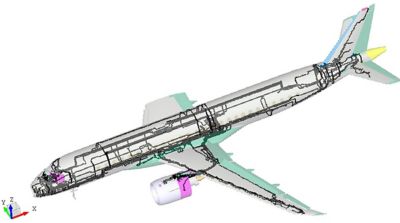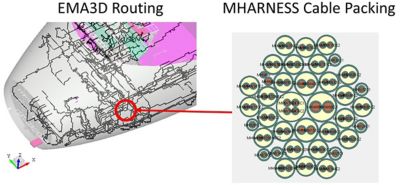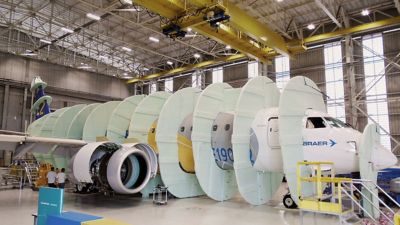-
-
학생용 무료 소프트웨어에 액세스하기
차세대 엔지니어에게 힘을 실어주는 Ansys
학생들은 세계적 수준의 시뮬레이션 소프트웨어를 무료로 이용할 수 있습니다.
-
지금 바로 Ansys에 연결하십시오!
미래를 설계하기
시뮬레이션이 다음 혁신을 어떻게 지원할 수 있는지 알아보려면 Ansys와 연결하십시오.
국가
무료 트라이얼
제품 및 서비스
학습하기
회사 정보
Back
제품 및 서비스
ANSYS BLOG
June 14, 2023
How Embraer Uses Simulation to Put Planes in the Air Faster
“Hey, let’s go zap an airplane with an artificial bolt of lightning and see what happens.”
While that sounds like one of those statements no one ever said, the opposite, in fact, is true. Airplane manufacturers have for years been subjecting prototypes of their planes to the electrical transient equivalent of a bolt of lightning just to see what will happen to the electrical equipment.
Ideally, nothing will happen. And that’s good, because airplanes are struck by real lightning more frequently than you might think. By one estimate, every plane in the U.S. commercial fleet is struck by lightning more than once a year. Because the plane is well engineered, none of its electronics will be affected by a pulse of high energy surging through the miles of cables in the plane. No fires will erupt due to current arcing at cable connection points. No one in the plane will be injured, killed, or even shocked by this event.
However, using an airplane prototype to validate its ability to survive a lightning attachment is costly, and the tests can take weeks to complete, even when all the testing proceeds without hiccups. Parked in a hangar and festooned from nose to tail with electromagnetic sensors, the prototype is effectively frozen in place for as long as it takes to complete the tests. Other scheduled tests simply need to wait until the lightning certification tests are complete. If the certification tests reveal issues — that critical electronics systems could be damaged or that lightning attaching to the wing could spark a fuel tank explosion — then the company might be looking at product corrections and redesigns that could be very expensive, and weeks or months of development time may be lost.
For all these reasons, the Brazilian airplane manufacturer Embraer strives to conduct as much of its indirect effects of lightning certification testing as it can via simulation. Using Ansys EMC Plus (formerly Ansys EMA3D Cable), Embraer’s product development engineers can perform all the critical tests in silico — along with additional “what-if” tests — that would be required to verify an airplane for lightning certification. In doing so, the company is able to bring a plane to market faster and at a notably lower cost.

Transport category aircraft CEM model developed for lightning ATL simulations. Exterior surfaces are shaded to show interior cable routing.
Testing the Plane Before the Plane Exists
Embraer is the third largest manufacturer of commercial jets in the world, producing more than 8,000 planes in the last 50 years. Known for its innovation and solid engineering, it’s no surprise that Embraer has embraced simulation. EMC Plus provides Embraer’s engineers with a dedicated, platform-level electromagnetic cable modeling simulation tool that specializes in analyzing lightning-induced electromagnetic (EM) effects as well as cable EMI/EMC problems to support EMC certification.
“We use Ansys EMC Plus to calculate the induction levels in the cables during a lightning attachment,” explains Rodrigo Freire, a product development engineer at Embraer. “To get certification to deliver a new aircraft, we need to show that the induction levels appearing at the interface of each device are within acceptable limits during a lightning attachment.”
If the end goal of simulation sounds like the end goal of physical testing, you’re right. Both approaches need to demonstrate that a lightning attachment won’t cause malfunctions of the electronics or the structure of the plane. The difference is that the team at Embraer doesn’t even need the physical plane to start analyzing whether those induction levels will be within acceptable limits.
In fact, Embraer has found it better for the entire development process if simulation takes place before a prototype is built. That way, if simulation uncovers concerns, the plane’s designers can address them before the plane is constructed and such modifications become much more complicated.
“Late in the design stages, it would be very difficult to move a cable harness or use a different component,” adds José Mariano, another product design engineer at Embraer. “Those are just not situations we would like to face at that point.”

Cable packing example configuration for forward electronics bay harness.
The Challenge of Testing Big Models
The challenge when simulating a lightning strike and its effects is that one ultimately does need to look at the entire airplane structure, and that’s not something all simulation tools can do easily or reliably. A bolt of lightning might attach to a plane’s extremities, coursing through all the cabling and conductive material between the two attaching points in fractions of a second. EMC Plus provides Embraer with the ability to work with both the smallest and the largest models required. It enables engineers to import cable and harness information from tools like Zuken and Capital Harness; it integrates that data with CAD drawings of airframes and printed circuit boards (PCBs) from Ansys Mechanical. Engineers can then run simulations involving everything from the effect of a lightning attachment on specific interfaces or specific materials to the effect of that attachment on the entire plane.
Some of the simulations run in just a few hours; others run to completion over the course of several days. Indeed, because it can conduct so many more tests in a relatively short period of time, Embraer gains insights faster than might normally happen if the only option were physical tests.

During physical testing, electrical discharges are created in a structure enveloping the aircraft. Induced current passing through a critical component’s harness is measured to evaluate the effects of lightning strikes. Image courtesy of Embraer.
“We may be running several simulations on just one or two designs just to see how design tweaks affect performance,” notes Mariano.
If Embraer relied exclusively on physical tests of a component’s response to lightning, it would become difficult to explore such design optimizations in the same way, as it takes more time and money to build, test, rebuild, and retest a physical model. Simulation enables Embraer to perform such comparative testing early in the design cycle, which enables the engineers to work more efficiently than they could otherwise.
Some estimates attribute using simulation to support complete EMC and EMI certification to cost savings in the millions of dollars.

Visualization of the surface current distribution computed by Ansys EMC Plus.
The Physical Validates the Simulated
Physical tests still play a role in lightning certification at Embraer, but not the same role they used to. Today, smaller scale physical tests can be run as a point of reference against which the simulation results can be compared. Embraer has been able to show a high correlation between its simulated outcomes and those captured in the physical baseline tests, which inspires a high confidence level that other simulation results would match the results of physical tests that were run.
“We have to make a certain number of assumptions when we’re running simulations,” says Freire, “but we have to make a lot of assumptions when we’re conducting physical tests as well. Test results do not always match the exact conditions that were anticipated for a plane experiencing a given lightning strike, but over time we’ve developed a pretty good idea of what to expect. Our simulations use the same standardized lightning characteristics — for example, amplitude and time-to-rise — that are important when it comes to analyzing and accurately anticipating the effects on electronic equipment.
“We have to show that the aircraft will still perform under the extreme electromagnetic conditions to which nature can subject an aircraft,” Freire continues. “As long as the simulations can capture the lightning transients as well as the physical tests would, and as long as the equipment shows that it can withstand those levels, then we’re going to meet the standards that are required for certification.”
In the end, Embraer’s use of simulation to achieve EMI and EMC certification may be proving the same thing that physical tests have always proven, that its planes are safe and well-engineered, that cargo and passengers will be safe, and that lightning attachments won’t cause problems when — not if — they occur. But Embraer’s use of EMC Plus is also proving something else: that simulation can dramatically reduce the time and cost of bringing a new, high-quality plane to market, and that is a benefit that has airplane manufacturers around the world sitting up and taking notice.